Detailed information about the city of Cartagena
Cartagena has about 200,000 inhabitants and is located in the southeast of Spain by the sea. The port of Cartagena is one of the largest in Spain. For the tourist Cartagena is interesting because of the many historical buildings and the location on the Costa Calida (hot coast). Even in January day temperatures of over 20 degrees are not rare here.
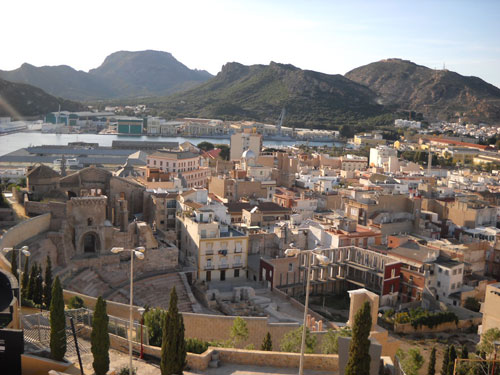
Cartagena was the capital of the Carthaginians in Europe. When the Romans conquered the city around 200 B.C., they called the city “New Carthage”, from which its present name derives. In the Middle Ages, Cartageno, like most of Spain, was Arabic for many centuries. The city has many sights, but the excavations in Cartagena are far from finished. Only in the last few years, for example, the central and the current cityscape of Cartagena’s formative Roman theater was excavated.
Places of interest Cartagena
If you arrive by bus or train, you can walk to the historic city centre in about 20 minutes. First you should visit the central castle “Castillo de la Concepcion”. There is not too much preserved of the castle, but one has a magnificent panorama from above to Cartagena (picture above), the big harbour, the Roman theatre (picture below) and the surrounding area. The Roman theatre directly under the castle can be entered since 2008.
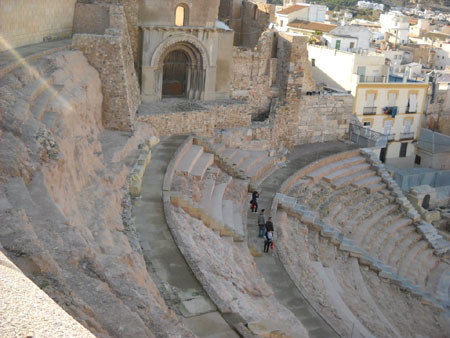
By visiting the castle grounds is free if you go up on foot (about 10 minutes). If you want to use the new elevator, you pay one Euro. Also nice are the peacocks, which run around freely in the castle and are fed by the tourists.
Great city tour of Cartagena on the subject of ancient Romans with tickets (entrance tickets): >>> More information and booking
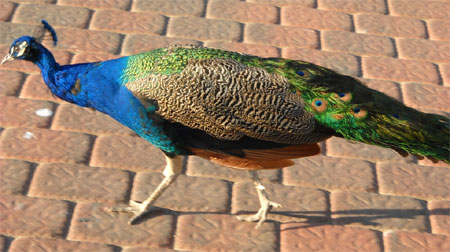
Down at the port of Cartagena, the main attraction is an exhibited submarine from the 19th century. It is probably the most photographed object in the port city. One of the most beautiful buildings in Cartagena is the town hall (picture below) and the venerable Gran Hotel of Cartagena.
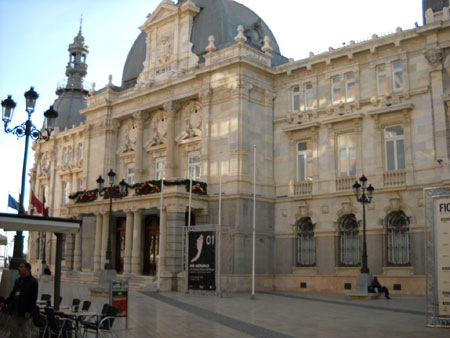
In the city centre, there is a pedestrian precinct that leaves from the town hall square on the shore, in which many inhabitants prefer to sit in the cosy street cafés rather than go shopping. On the shore there is a large square and beautiful green areas. Especially in the city centre, Cartagena makes a very prosperous impression.
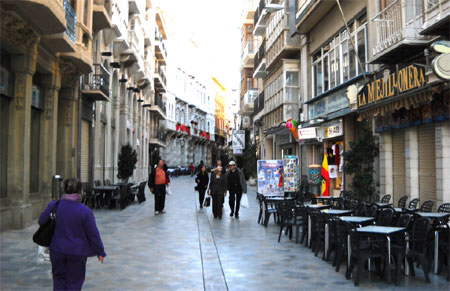
Large parts of the city are dominated by the huge commercial port. More cargo is handled here than in any other southern Mediterranean port in Spain. Before tourism, the port is the most important economic sector in the second largest city in the province of Murcia.
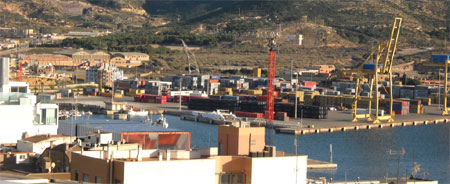
Roman Theater Cartagena
The famous Roman Theater of Cartagena is an ancient Roman theater in the city of Cartagena in the Murcia region of southeastern Spain. It was founded in the 1st century B.C. founded. century B.C. It was built around 1000 BC and was used for theatrical performances, gladiator fights and other public events.
Great city tour of Cartagena on the subject of ancient Romans with tickets (entrance tickets): >>> More information and booking
The theater operated for around 400 years before being abandoned and falling into disrepair. Over time, the ruins were buried under the city and fell into oblivion until they were rediscovered during construction work in 1988. Since then the theater has been excavated and restored and is now one of the most important archaeological sites in Cartagena. Today, visitors can explore Cartagena’s Roman Theater and learn about its fascinating history. The facility includes a large stage, seating, a backstage area and a museum with exhibits on the history and archeology of the theatre. Visitors can also enjoy audio-visual presentations and guided tours that provide information about the history and culture of the Roman Empire.
In addition to the theater, the site also contains other important Roman remains, such as the Punic Walls, which date back to the 3rd century AD. All in all, the Roman Theater in Cartagena is a must-see for history buffs and anyone interested in Spain’s rich cultural heritage.
Cartagena Naval Museum
The Naval Museum of Cartagena, also known as the National Archaeological Naval Museum, is a museum in the historical arsenal of Cartagena in the Murcia region of southeastern Spain. The museum showcases Cartagena’s rich naval history, dating back to the 16th century, and houses a collection of maritime artifacts and archaeological treasures.
Housed in a historic building that was formerly a dockyard and warehouse, the museum features exhibits from various areas of maritime history, including maritime trade, shipbuilding, navigation, and naval warfare. Exhibits include a collection of model ships, historical artifacts, and interactive displays that bring Cartagena’s naval history to life.
One of the highlights of the museum is the display of the Peral submarine, the first battery-powered submarine invented by Spanish engineer Isaac Peral in 1888. Visitors can see the submarines up close and learn about their innovative design and impact on naval warfare.
The museum also includes a library and research center with an extensive collection of books, maps and documents related to naval history, and a restoration workshop where visitors can see how professionals conserve and restore artifacts.
Overall, the Cartagena Naval Museum is a must-see for anyone interested in naval history and maritime culture. It offers an interesting insight into the history of the Cartagena Navy and its important role in Spanish history.
Castle Cartagena Castillo de la Concepcion
The Castillo de la Concepcion is a hilltop fortress overlooking the city of Cartagena in the Murcia region of southeastern Spain. The history of the castle dates back to the 13th century and played an important role in the history of Cartagena as it served as a defensive fortress and later as a cultural center.
The castle has been restored and turned into a cultural center and museum where visitors can learn about the history and culture of Cartagena. The grounds offer a variety of exhibitions and exhibits, including a collection of artefacts and archaeological finds from the castle and the surrounding area.
One of the highlights of the castle is the panoramic view of the city and surrounding countryside. Visitors can climb the castle towers to enjoy the stunning views and peaceful surroundings.
Various cultural events and exhibitions are held in the castle throughout the year, including concerts, art exhibitions and theater performances. The castle’s scenic location and historic charm make it a popular venue for weddings and other special events.
Overall, Concepcion Castle is a must-see for anyone interested in Cartagena’s history and culture. The stunning scenery and cultural offerings make it a popular destination for tourists and locals alike.
Great city tour of Cartagena on the subject of ancient Romans with tickets (entrance tickets): >>> More information and booking
Cartagena Cathedral
Cartagena Cathedral, also known as the Cathedral of Santa Maria, is a Roman Catholic cathedral in the city of Cartagena in the Murcia region of southeastern Spain. Built in the 13th century on the site of an old mosque, the cathedral has undergone several renovations and additions over the years, mixing Gothic, Renaissance and Baroque architectural styles.
The facade of the cathedral features beautiful rose windows and finely carved portals. The interior of the cathedral is equally impressive, with high ceilings, beautiful stained glass windows, and numerous ornate altars and chapels.
One of the cathedral’s highlights is the Chapel of the Immaculate Conception, which houses a sculpture of the Virgin Mary, which is carried through the streets of Cartagena during the annual Holy Week procession. Another special feature of the cathedral is the Chapel of the Holy Sacraments with its impressive altarpiece and beautiful organ from the 18th century.
Visitors to Cartagena Cathedral can take a guided tour to learn about the history and architecture of the cathedral and its role in Cartagena’s religious and cultural life. The cathedral hosts numerous concerts and cultural events throughout the year, including performances by local choirs and orchestras. Overall, Cartagena Cathedral is a must-see for anyone interested in Cartagena’s history, architecture and religious culture.
Great city tour of Cartagena on the subject of ancient Romans with tickets (entrance tickets): >>> More information and booking
Casa de la Fortuna
Casa de la Fortuna is a historic Roman villa in the city of Cartagena in the Murcia region of southeastern Spain. The villa dates from the 1st century BC. It is one of the best preserved examples of Roman architecture in the region.
The villa features a number of beautiful mosaics and frescoes, as well as a courtyard with a small pool. The mosaics depict scenes from Roman mythology, such as the story of Narcissus and the four seasons. The frescoes, painted directly on the walls, represent various scenes, including landscapes, animals and mythological figures. In addition to the architectural and artistic features, the Casa de la Fortuna also offers valuable insights into the daily life of the Roman elite. The villa has several rooms including a dining room, a kitchen, a bathroom and numerous private rooms.
Visitors to the Casa de la Fortuna can take a guided tour of the villa to learn about the villa’s history and architecture, as well as the daily life of the Romans who once lived there. The villa hosts various cultural events throughout the year, including concerts, theatrical performances and contemporary art exhibitions.
Punic Walls Cartagena
The Punic Walls are historic defensive walls of the city of Cartagena in the Murcia region of southeastern Spain. The walls date back to the 3rd century BC. back. It was built by the Carthaginians to protect the city and was then known as Qalt Hadast.
The Pueni Wall, made of large blocks of stone, stretches for 2 km and forms a semicircle around the historic center. The city walls have several towers and gates, including the Puerta de la Muralha, which once served to control access to the city.
In addition to their historical importance as a defensive structure, the Punic Walls are also a valuable archaeological site, providing a glimpse into the daily life of the city’s Carthaginian inhabitants. Excavations have unearthed numerous artefacts, including ceramics, jewelry and coins, which are now on display in the city’s museums.
Visitors to the Punic Walls can take a guided tour to learn about the history, archeology and the walls’ role in protecting the city. There are also beautiful views of the surrounding countryside and the Mediterranean Sea from the walls, making it a popular destination for photographers and tourists.
Great city tour of Cartagena on the subject of ancient Romans with tickets (entrance tickets): >>> More information and booking
Calle Mayor – Cartagena’s main street
Calle Mayor is a pedestrian street in the center of Cartagena in the Murcia region of southeastern Spain. It dates back to Roman times and is one of the oldest streets in the city. Today it is a focal point for shopping, dining and entertainment.
The streets are lined with historic buildings that mix Gothic, Baroque and Neoclassical architectural styles. Many of the buildings have been beautifully restored and now house shops, cafes, restaurants and bars, making them popular destinations for tourists and locals alike.
Calle Mayor is home to many cultural and historical attractions, including the 19th-century Palacio Consistorial (City Hall) with its neoclassical and Renaissance architecture. Also down the street is Casa Llagostera, a historic 18th-century building that now houses the Regional Museum of Modern Art.
As well as its cultural and historical attractions, Calle Mayor is also known for its lively atmosphere, especially in the evenings when residents and tourists alike enjoy the street’s many restaurants, bars and cafes. All in all, Calle Mayor is a unique mix of history, culture and entertainment.
Accommodation in Cartagena
Of course, in a touristy city like Cartagena, there is a multitude of hotels and guesthouses. However, especially in summer it is not easy to find a simple, cheap room. In the high season you should definitely book in advance. The Hotel Los Habaneros is quite good and relatively inexpensive. Good rooms cost about 50 to 60 euros in summer. It’s hard to find cheaper in Cartagena. If you have your laptop or smartphone with you, you can use the internet in Los habeneros free of charge via WLAN. More information and online booking option here
Arrival Cartagena
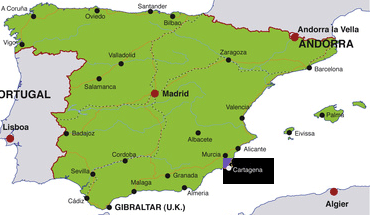
Picture: © Gerhard Egger – Fotolia.com
There’s only one railroad to the city. All trains go to Murcia and from here in different directions (Alicante, Valencia or Madrid). There are more than 10 trains a day to Murcia, the regional trains cost 5.45 euros at the beginning of 2015, the faster trains a little more.
There are many more connections from the bus station. The bus line Cartagena – Torrevieja – Santa Pola – Alicante is often used by holidaymakers. The only way to the south is by bus (e.g. Almeria, Granada with Alhambra or Malaga), there is no railway line along the coast. The Mediterranean motorway AP-7 passes directly by Cartagena (just take the exit Cartagena).
Our tips: Prepare good websites for holidays in Spain for the 2025 season |
Are you looking for cheap hotels in Spain >>> Click heree
|
Best Website for Bus Excursions, Tickets …: >>> Click Here |
Cheap rental cars in Spain: >>> Click here |
You should buy the Vienna Pass for Vienna online.